MACAQUE FACTS
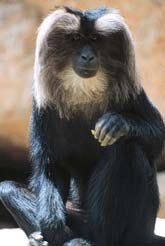
| Family:Cercopithecidae | Subfamily:Cercopithecinae |
| Genus:Macaca | Species:sixteen -- |
- arctoides (stump-tailed macaque)
- assamensis (Assamese macaque)
- cyclopis (Formosan rock macaque)
- fascicularis (long-tailed or crab-eating macaque)
- fuscata (Japanese macaque)
- maura (Celebes moor macaque)
- mulatta (rhesus macaque)
- nemestrina (pig-tailed macaque)
- nigra (Celebes or Sulawesi crested black macaque)
- ochreata (booted macaque)
- radiata (bonnet macaque)
- silenus (lion-tailed macaque)
- sinica (toque macaque)
- sylvanus (barbary macaque)
- thibetana (Tibetan macaque)
- tonkeana (Tonkean macaque)
-
Various subspecies have been identified. A few species classifications are disputed.
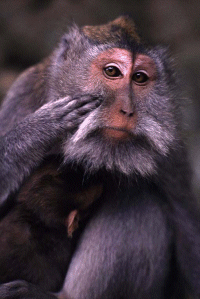 Appearance:
Appearance:
Most macaques are some shade of brown with some grey or white. A few are black. They have hairless faces and cheek pouches. They often have light-colored eyelids which accentuate facial expressions. Many, but not all, have short tails. The majority are around 20-25 inches long (some are larger) with a weight range of about 15-30lbs (give or take a few.) Males tend to be somewhat larger than females. Macaques, like other Old World monkeys, are second only to humans in their ability to use their fingertips and opposable thumbs to manipulate small objects.
Range and Diet:
Macaques can be found in more climates and habitats than any other primate, save humans - ranging from Japan to Morocco. Forest habitats seem to be preferred. All but one macaque species reside in some part of Asia and are quite widespread. Several live in close association with humans. Macaques are omnivorous, though fruit tends to be primary. They've been known to raid crops in some areas. They make use of quite a few plant species in whatever area they are found.
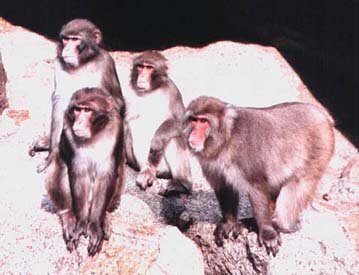
Behavior and Social Structure:
Macaques are diurnal, and both arboreal and terrestrial. They normally form multimale-multifemale groups with strong hierarchies, often determined by the mother's rank. Females usually outnumber males. Macaques have quite complex social and behavioral systems which are difficult to summarize. Some tool-use and cultural innovations have been observed. Group size can vary from 10 up to around 100 individuals. Group fusion and fission occurs. These monkeys can be quite aggressive, both to each other and to other species. Rhesus macaques were observed mobbing a tiger, and stump-tailed macaques are feared by locals. They tend to be the dominant species whenever they are found in association with other monkeys. They also form friendships and coalitions. They have a wide range of vocalizations, and also communicate by gesture and facial expressions. These calls and gestures were found to have specific meanings.
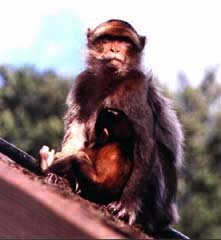 Reproduction and Lifespan:
Reproduction and Lifespan:
Mating can be year round, though there tends to be a peak season, which may correspond with food availability. Females in estrus generally display swelling and/or color change. Competition is fierce, and females exercise choice, sometimes prefering a less dominant male - these encounters occur with some clever plotting on the part of the participants. Tonkean macaques may hybridize with booted macaques.
Males associative with and care for infants. Some allomothering has been observed. Dominant females have been known to kidnap the infants of subordinates. Sexual maturity normally occurs within 3-4 years. Males normally emigrate (sometimes females will,) and can remain solitary or form all-male groups. Macaques can live 20-40 years.
Conservation Status:
Lower Risk macaques (CITES II): crab-eating, rhesus, bonnet
Vulnerable macaques (IUCN): stump-tailed, Assamese, Celebes moor, pig-tailed, barbary, Tonkean
Threatened macaques (USESA): Formosan rock, toque
Endangered macaques (USESA): Japanese, Celebes, lion-tailed
Data Deficient (IUCN): booted macaque, Tibetan macaque
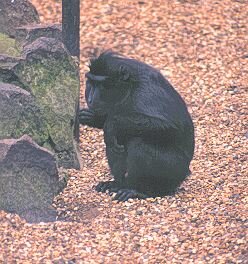 Interesting Macaque Facts:
Interesting Macaque Facts:
The barbary macaque is the only macaque to live outside of Asia, and the only monkey in Europe, introduced for sport to Gibraltar in the 18th century.
The rhesus macaque has adapted to life in cities. Some rhesus are fed by humans near Hindu temples in India.
Macaques are the most common monkey used in biomedical research.
Tibetan macaques are fed near temples in China.
Japanese macaques live at the northernmost latitude of any nonhuman primate. They are good swimmers and make use of natural hot springs to keep warm in winter. Field research on Japanese macaques revealed the first known case of cultural innovation in nonhuman primates. They have been officially protected in Japan since 1947.
The first free-ranging American colony of Japanese macaques was established in Texas in 1972. These have invented a new alarm call especially for rattlesnakes.
The endangered Sulawesi (Celebes) macaque is a favored delicacy for Christmas dinner in Indonesia. They recently underwent a name change along with the islands they live on. They are often incorrectly called "apes" because they are jet black and appear to be tail-less (actually they do have a very short tail.)
The calls of lion-tailed macaques are similar in structure to those of the Nilgiri langur, which lives in the same area. This is thought to be a case of convergent evolution. Lion-tailed macaques are the most arboreal of all the macaque species.
Pig-tailed macaques are trained to harvest coconuts.
Current Research with Macaques
References:
Rowe N (1996) The Pictorial Guide to the Living Primates. East Hampton: Pogonias Press
Sleeper B (1997) Primates. San Francisco: Chronicle Books
